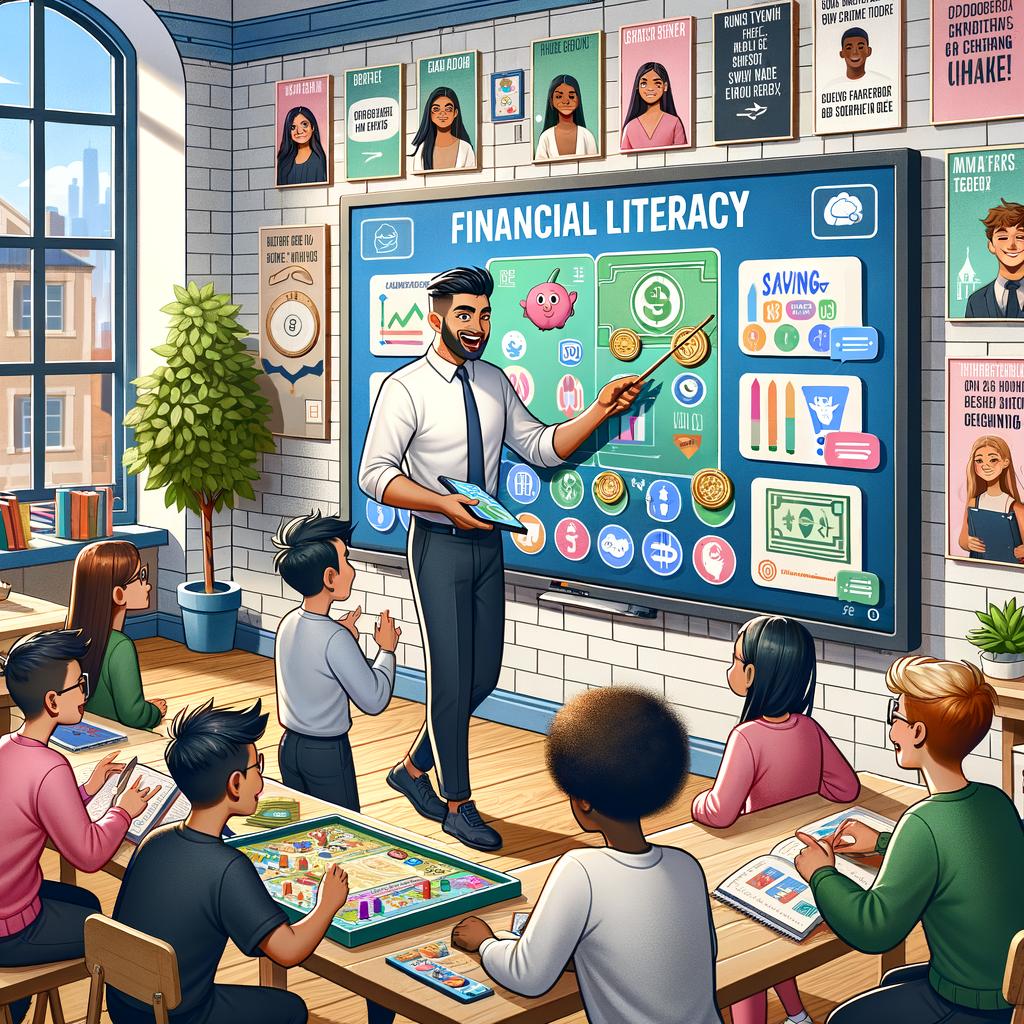In the bustling corridors of our educational institutions, the echoes of future dreams and aspirations reverberate daily. Students diligently dissect mathematical equations, unravel literary masterpieces, and explore the vast expanse of scientific phenomena. Yet, amid this cacophony of learning, a crucial symphony remains muted—financial literacy. As we equip our youth with the knowledge to navigate complex subjects, we must question: Are we neglecting to prepare them for one of life’s most pervasive challenges, managing their finances? This article delves into why financial literacy should no longer be an overlooked chapter in our educational narrative, but rather a cornerstone of student success.
Table of Contents
- Building Strong Foundations: The Importance of Early Financial Education
- Empowering Teachers with the Right Tools and Resources
- Innovative Curriculum Ideas to Make Financial Literacy Engaging
- Collaborating with Financial Experts to Enhance Classroom Learning
- Q&A
- Key Takeaways

Building Strong Foundations: The Importance of Early Financial Education
Financial literacy has long been an underrated subject in our education system. Yet, as the world becomes increasingly interconnected and complex, the ability to manage one’s finances is an essential skill that, when nurtured from a young age, can lay the groundwork for a stable and prosperous future. Early financial education equips students with the tools they need to navigate the often-turbulent waters of personal and global economies.
Imagine a classroom where students learn about budgeting, saving, and investing alongside their traditional subjects. In this environment, children are not just taught to memorize figures and formulas but to apply practical financial skills in their daily lives. Integrating financial literacy into the core curriculum encourages students to think critically about their financial decisions and understand the long-term consequences of their actions.
Research indicates that children who receive financial education are more likely to develop responsible spending habits, avoid debt, and build substantial savings. By starting early, we can instill a sense of fiscal responsibility that will benefit them throughout their adult lives. Consider the following essential components of a well-rounded financial education program:
- Budgeting basics
- The power of compound interest
- Understanding credit
- Investment principles
- Debt management
Take for instance the concept of compound interest. When introduced early, students grasp how their money can grow exponentially over time when invested wisely. They learn the value of saving at a young age and see firsthand how small, consistent investments can lead to significant financial security.
| Age Group | Concept | Real-Life Application |
|---|---|---|
| 6-10 years | Basic Saving | Starting a piggy bank |
| 11-14 years | Budgeting | Managing allowance |
| 15-18 years | Credit & Debt | Understanding loans and credit cards |
By incorporating these concepts into the educational system, we prepare students not just for academic success, but for real-world challenges. Moreover, financial literacy transcends socioeconomic boundaries, giving every student the opportunity to build a solid financial foundation, regardless of their background.
Our schools must seize the opportunity to champion financial literacy. By making it an integral part of the curriculum, we not only enhance individual futures but also foster a more financially astute and resilient society. Avoiding the pitfall of treating financial education as an afterthought will yield dividends for generations to come.
It’s imperative for educators, policymakers, and parents to advocate for stronger financial education programs in schools. The sooner we start to see financial literacy as a core skill, the better prepared our children will be to handle the economic realities of tomorrow.

Empowering Teachers with the Right Tools and Resources
Teachers are the cornerstone of our education system, guiding young minds through the labyrinth of knowledge. To tackle the evolving demands of modern education, providing them with the right tools and resources is essential, particularly in the area of financial literacy. By empowering educators, we lay the groundwork for generations of financially informed and responsible students.
<p>One effective approach is to integrate comprehensive financial literacy modules into the curriculum. These modules should include a mix of theoretical knowledge and practical application, covering topics such as budgeting, saving, investing, and understanding credit. A well-rounded curriculum ensures students grasp the complexities of financial decision-making at an early stage.</p>
<p>Professional development for teachers is another critical element. Regular workshops, seminars, and online courses can keep educators updated with the latest financial concepts and teaching strategies. Schools might also consider partnerships with financial experts and institutions to bring additional expertise and real-world insights into the classroom.</p>
<p>To support teachers effectively, schools can provide:
<ul>
<li><b>Interactive learning tools:</b> Gamified financial education platforms make learning engaging and memorable.</li>
<li><b>Comprehensive lesson plans:</b> Curated content that aligns with educational standards and offers diverse teaching strategies.</li>
<li><b>Assessment and tracking tools:</b> Resources that help monitor student progress and identify areas needing improvement.</li>
</ul>
</p>
<p>Consider the following table highlighting essential resources and their benefits:</p>
<table class="wp-block-table alignwide">
<thead>
<tr>
<th><strong>Resource</strong></th>
<th><strong>Benefit</strong></th>
</tr>
</thead>
<tbody>
<tr>
<td>Lesson Plans</td>
<td>Structured approach to ensure coverage of key concepts</td>
</tr>
<tr>
<td>Financial Simulations</td>
<td>Hands-on experience in a risk-free environment</td>
</tr>
<tr>
<td>Workshops</td>
<td>Ongoing professional development and up-to-date training</td>
</tr>
</tbody>
</table>
<p>Collaboration among educators to share best practices and successful approaches is equally important. Online forums and teacher networks serve as valuable platforms for idea exchange and peer support. These collaborative environments foster innovation and build a robust support system for teaching financial literacy.</p>
<p>Establishing partnerships with businesses and financial institutions can also bring a wealth of resources into schools. These partnerships may result in guest lectures, internships, and hands-on workshops, providing students with real-world financial insights that textbooks alone cannot offer.</p>
<p>Lastly, incorporating technology can significantly enhance the learning experience. Apps and digital platforms tailored to financial literacy education make learning more interactive and accessible. They offer students the chance to engage with financial concepts through simulations, quizzes, and interactive lessons, making abstract ideas more tangible.</p>
<p>By equipping teachers with these vital tools and resources, we ensure they are well-prepared to impart essential financial knowledge to their students. This educational foundation is crucial in empowering the next generation to make informed financial decisions, fostering a financially savvy society.</p>

Innovative Curriculum Ideas to Make Financial Literacy Engaging
Introducing children to financial concepts early can establish a foundation for sound money management in adulthood. Here are a few innovative ways to transform dry financial lessons into engaging, memorable experiences.
- Interactive Games and Simulations – Gamify financial lessons by using simulations that mirror real-life financial decisions. Students can virtually invest, save, and spend money, allowing them to see the consequences of their choices in a risk-free environment.
- Role-playing Scenarios – Implement role-playing situations where students must navigate financial challenges like buying a house, managing a budget, or planning for retirement. This approach enhances their problem-solving skills while making learning enjoyable.
- Monthly Class Shops – Create a classroom economy with ‘Class Currency.’ Students can earn and spend this currency in a monthly class shop. This hands-on method helps them understand spending, saving, and the value of money.
Utilize story-based learning by incorporating narratives that highlight the journey of fictional characters making financial decisions. This narrative method can make abstract concepts relatable and easier to comprehend.
Collaborate with local businesses to provide real-world insights. Guest speakers like financial advisors or entrepreneurs can share valuable experiences, giving students a practical perspective on managing finances.
Using technology is a great way to capture students’ interest. Educational apps that focus on budgeting, saving, or investing can be an interactive companion to traditional teaching methods. Additionally, virtual stock market games can introduce students to investing in a dynamic and engaging manner.
Here’s an example comparison of popular financial apps for the classroom:
| App | Feature | Cost |
|---|---|---|
| Saving Star | Helps track savings goals | Free |
| Stock Market Pro | Virtual stock trading | $5/month |
| Budget Buddy | Personal budgeting tools | Free |
Another innovative idea is to integrate cross-curricular projects that link financial literacy to subjects like math and social studies. For instance, a math project could involve calculating interest rates on imaginary loans, while a social studies project might explore the economic impacts of historic events.
encourage family involvement by providing take-home activities and discussions. Financial literacy shouldn’t stop at the classroom door; integrating it into everyday family life can reinforce lessons learned in school and set students up for long-term success.

Collaborating with Financial Experts to Enhance Classroom Learning
Engaging financial experts to integrate financial literacy into the curriculum can breathe new life into the classroom environment. Imagine students not only understanding key financial concepts but also applying them through practical, real-world scenarios. Teachers and financial professionals, working together, offer a dynamic approach that transcends traditional textbook learning.
Advantages of Expert Collaboration:
- Diverse Perspectives: Financial professionals bring a wealth of industry insights and real-world examples that can make learning more relevant and engaging.
- Practical Application: By partnering with financial experts, lessons can be structured around real-world applications, bridging the gap between theory and practice.
- Increased Motivation: Relating classroom lessons to future careers and personal lives can increase student interest and motivation.
A well-structured program involving financial experts might include guest lectures, workshops, and interactive projects. In this collaborative setup, students get the chance to pose questions directly to industry professionals, making learning more interactive and engaging. Guest lectures can range from basic personal finance tips to elaborate discussions on global economic trends, ensuring that students of all levels remain engaged and informed.
Interactive projects can serve as the cornerstone of this collaboration, allowing students to simulate financial decision-making processes. These projects may involve budgeting exercises, investment simulations, and financial planning cases. Here’s a simple table layout for potential interactive projects:
| Project | Description | Skills Developed |
|---|---|---|
| Budgeting Exercise | Students create and manage a personal budget. | Financial planning, critical thinking |
| Investment Simulation | Students simulate stock market investments over a period of time. | Risk assessment, analytical skills |
| Financial Planning Case | Students develop a financial plan for a fictional family scenario. | Problem-solving, strategic planning |
Furthermore, financial experts can assist in creating customized learning materials that reflect current trends and technological advancements. These materials could include e-books, interactive software, and online courses, making education more accessible and tailored to the digital age.
Regular assessments and feedback sessions can ensure that the collaboration is continually meeting educational goals. Regular check-ins with both students and experts can provide invaluable insights into the program’s strengths and areas for improvement. This adaptive approach ensures that the curriculum remains dynamic and effective over time.
Moreover, professional development opportunities for teachers should not be overlooked. Financial experts could provide specialized training for educators, equipping them with the latest tools and techniques in financial education. These training sessions can cover a variety of topics such as emerging financial technologies, investment strategies, and effective teaching methodologies.
A final, yet crucial element is the establishment of long-term partnerships between schools and financial institutions. Such alliances can foster ongoing access to resources, guest speakers, and updated financial data, ensuring that the curriculum remains up-to-date and comprehensive.
Q&A
Q: Why is financial literacy important for students?
A: Financial literacy equips students with the knowledge and skills to make informed and effective decisions regarding their personal finances. This foundation helps them navigate life’s financial challenges, from budgeting and saving to investing and managing credit. When students understand financial principles, they are better prepared for future responsibilities, contributing to their overall well-being and economic stability.
Q: What are the current shortcomings in financial literacy education in schools?
A: Many schools treat financial literacy as an afterthought, often lacking a structured curriculum dedicated to this crucial subject. As a result, students graduate without a solid understanding of basic financial concepts. This gap leaves them vulnerable to financial pitfalls and unable to fully grasp the importance of managing money effectively. The current educational framework often fails to prioritize financial literacy, leading to inconsistencies in how and when these essential skills are taught.
Q: How can integrating financial literacy into the school curriculum benefit students?
A: Integrating financial literacy into the school curriculum ensures that all students receive a comprehensive education in managing money. It empowers them with practical skills and knowledge, allowing them to make sound financial decisions throughout their lives. This integration can lead to better financial outcomes for individuals and society, reducing debt levels, improving credit scores, and fostering a culture of mindful financial management. Moreover, it helps build confidence in students, enabling them to face financial challenges with greater assurance.
Q: What role do teachers play in promoting financial literacy?
A: Teachers are pivotal in promoting financial literacy. They help demystify financial concepts and present them in an engaging, accessible manner. By incorporating real-life examples and interactive activities, teachers can make financial literacy relatable and interesting. Moreover, they serve as role models, demonstrating good financial habits and encouraging discussions about money management. With proper training and resources, teachers can effectively instill the importance of financial literacy in their students, leaving a lasting impact.
Q: What steps can schools take to prioritize financial literacy?
A: Schools can take several steps to prioritize financial literacy. Firstly, they can introduce mandatory financial literacy courses as part of the core curriculum. Secondly, schools can offer professional development for teachers to equip them with the necessary tools and knowledge to teach financial literacy effectively. Collaborating with financial institutions and experts to provide workshops and guest lectures can also enhance the depth of financial education. Lastly, incorporating financial literacy topics in existing subjects such as math and social studies can reinforce these critical skills across various domains.
Q: Are there any long-term societal benefits to improving financial literacy education in schools?
A: Absolutely. Improving financial literacy education in schools can lead to long-term societal benefits. Financially literate individuals are more likely to make informed decisions, which can reduce the incidence of debt and financial crises. This, in turn, can lead to a more stable economy, as individuals with strong financial skills contribute to sustainable economic growth. Moreover, widespread financial literacy promotes equitable wealth distribution and reduces economic disparities, fostering a more balanced and inclusive society. By prioritizing financial education, we invest in a financially savvy future generation, capable of making smarter economic choices.
Key Takeaways
As we navigate an increasingly complex financial landscape, the importance of embedding financial literacy into our educational fabric cannot be overstated. By prioritizing this vital skill, we empower students not only to manage their personal finances adeptly but also to contribute more meaningfully to a resilient and prosperous society. It’s not merely about balancing budgets or understanding interest rates—it’s about fostering a generation capable of making informed, responsible financial decisions. The time is now for our schools to evolve, making financial literacy not an afterthought, but a cornerstone of the education system. In doing so, we invest in a future where everyone has the knowledge to thrive.
